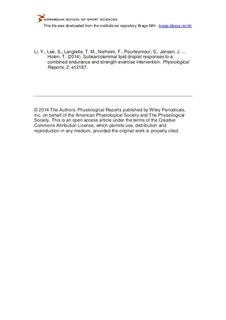| dc.contributor.author | Li, Yuchuan | |
| dc.contributor.author | Lee, Sindre | |
| dc.contributor.author | Langleite, Torgrim | |
| dc.contributor.author | Norheim, Frode | |
| dc.contributor.author | Pourteymour, Shirin | |
| dc.contributor.author | Jensen, Jørgen | |
| dc.contributor.author | Stadheim, Hans Kristian | |
| dc.contributor.author | Storås, Tryggve H. | |
| dc.contributor.author | Davanger, Svend | |
| dc.contributor.author | Gulseth, Hanne L. | |
| dc.contributor.author | Birkeland, Kåre I. | |
| dc.contributor.author | Drevon, Christian A. | |
| dc.contributor.author | Holen, Torgeir | |
| dc.date.accessioned | 2015-03-20T11:51:37Z | |
| dc.date.available | 2015-03-20T11:51:37Z | |
| dc.date.issued | 2014 | |
| dc.identifier.citation | Physiological Reports. 2014, 2, e12187 | nb_NO |
| dc.identifier.uri | http://hdl.handle.net/11250/279995 | |
| dc.description | © 2014 The Authors. Physiological Reports published by Wiley Periodicals, Inc. on behalf of
the American Physiological Society and The Physiological Society | nb_NO |
| dc.description.abstract | Muscle lipid stores and insulin sensitivity have a recognized association although the mechanism remains unclear. We investigated how a 12‐week supervised combined endurance and strength exercise intervention influenced muscle lipid stores in sedentary overweight dysglycemic subjects and normal weight control subjects (n = 18). Muscle lipid stores were measured by magnetic resonance spectroscopy (MRS), electron microscopy (EM) point counting, and direct EM lipid droplet measurements of subsarcolemmal (SS) and intramyofibrillar (IMF) regions, and indirectly, by deep sequencing and real‐time PCR of mRNA of lipid droplet‐associated proteins. Insulin sensitivity and VO2max increased significantly in both groups after 12 weeks of training. Muscle lipid stores were reduced according to MRS at baseline before and after the intervention, whereas EM point counting showed no change in LD stores post exercise, indicating a reduction in muscle adipocytes. Large‐scale EM quantification of LD parameters of the subsarcolemmal LD population demonstrated reductions in LD density and LD diameters. Lipid droplet volume in the subsarcolemmal LD population was reduced by ~80%, in both groups, while IMF LD volume was unchanged. Interestingly, the lipid droplet diameter (n = 10 958) distribution was skewed, with a lack of small diameter lipid droplets (smaller than ~200 nm), both in the SS and IMF regions. Our results show that the SS LD lipid store was sensitive to training, whereas the dominant IMF LD lipid store was not. Thus, net muscle lipid stores can be an insufficient measure for the effects of training. | nb_NO |
| dc.language.iso | eng | nb_NO |
| dc.publisher | The American Physiological Society | nb_NO |
| dc.subject | electron microscopy | nb_NO |
| dc.subject | exercise | nb_NO |
| dc.subject | insulin sensitivity | nb_NO |
| dc.subject | lipid droplets | nb_NO |
| dc.subject | lipophagy | nb_NO |
| dc.subject | muscle | nb_NO |
| dc.title | Subsarcolemmal lipid droplet responses to a combined endurance and strength exercise intervention | nb_NO |
| dc.type | Journal article | nb_NO |
| dc.type | Peer reviewed | nb_NO |
| dc.subject.nsi | VDP::Medical disciplines: 700::Basic medical, dental and veterinary science disciplines: 710::Human and veterinary science physiology: 718 | nb_NO |
| dc.source.journal | Physiological Reports | nb_NO |
| dc.description.localcode | Seksjon for fysisk prestasjonsevne / Department of Physical Performance | nb_NO |
